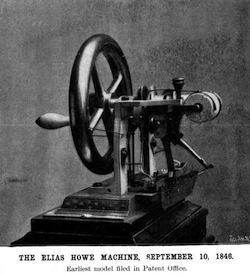
On this day in 1819, Elias How the american inventor and sewing machine pioneer was born.
Contrary to popular belief, Howe was not the first to conceive of the idea of a sewing machine. Many other people had formulated the idea of such a machine before him, one as early as 1790, and some had even patented their designs and produced working machines, in one case at least 80 of them. However, Howe originated significant refinements to the design concepts of his predecessors, and on September 10, 1846, he was awarded the first United States patent (U.S. Patent 4,750) for a sewing machine using a lockstitch design. His machine contained the three essential features common to most modern machines:
- a needle with the eye at the point,
- a shuttle operating beneath the cloth to form the lock stitch, and
- an automatic feed.
Despite securing his patent, Howe had considerable difficulty finding investors in the United States to finance production of his invention, so his elder brother Amasa Bemis Howe traveled to England in October 1846 to seek financing. Amasa was able to sell his first machine for £250 to William Thomas of Cheapside, London, who owned a factory for the manufacture of corsets, umbrellas and valises. Elias and his family joined Amasa in London in 1848, but after business disputes with Thomas and failing health of his wife, Howe returned nearly penniless to the United States. His wife Elizabeth, who preceded Elias back to the United States, died in Cambridge, Massachusetts shortly after his return in 1849.
Despite his efforts to sell his machine, other entrepreneurs began manufacturing sewing machines. Howe was forced to defend his patent in a court case that lasted from 1849 to 1854 because he found that Isaac Singer with cooperation from Walter Hunt had perfected a facsimile of his machine and was selling it with the same lockstitch that Howe had invented and patented. He won the dispute and earned considerable royalties from Singer and others for sales of his invention.